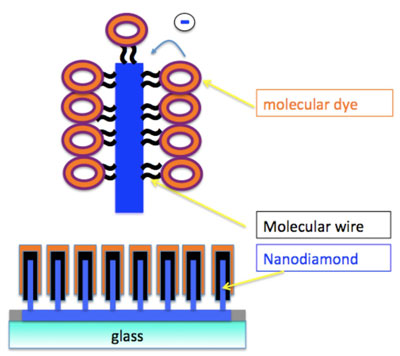| Aug 22, 2011 |
MOLESOL, new European project to develop a novel generation thin-film dye-sensitized solar cells
|
|
(Nanowerk News) A new European project called MOLESOL has been set up to demonstrate a revolutionary pathway for fabricating low-cost, high-efficiency and stable solar cells. The envisaged solar cell will be a hybrid device that consists of dye monolayers that are linked through an organic molecular wire to a semiconducting thin film deposited on a transparent substrate.
|
|
The MOLESOL project comes with a novel solar cell concept that aims to combine the advantages of two existing low-cost solutions, i.e. organic solar cells and thin-film dye-sensitized solar cells, in order to fabricate low-cost, stable and highly efficient solar cells.
|
 |
| MOLESOL: Proposed concept of the molecular wire solar cell.
|
|
Organic solar cells have to demonstrate long-term stability and power conversion efficiencies above 10% in order to be competitive with Si and copper-indium-gallium-selenide (CIGS) technologies. Today, the highest power conversion efficiency for an organic solar cell based on a bulk heterojunction device with PCBM and low-bandgap conjugated polymers is 8.3%, but this system is reaching its limit. Dye-sensitized solar cells are a promising cost-effective alternative, reaching efficiencies above 11%. These thin-film solar cells are based on a semiconductor formed between a photosensitized anode and an electrolyte. But problems with the stability of the electrolyte raise great concerns.
|
|
The novel solar cell will consist of a dye coupled through an organic molecular wire to a conductive electrode, hereby combining the advantages of both organic solar cells and dye sensitized solar cells. In practice, the ITO electrode currently used in dye-sensitized solar cells will be replaced by a novel transparent wide-bandgap p-type semiconductor (graphene or diamond). In addition, a highly efficient molecular-wire charge platform will be developed, that will make use of short, optimized molecular wires that couple the dye onto the semiconducting surface.
|
|
In this EU FP7 program, Imec/Imomec is involved in the development of an efficient molecular wire platform (collection layer, molecular dyes and molecular wire couplings). Imec is also coordinator of this 3-years project started in October 2010. Other project partners are Solarprint Limited, Ireland; Ustav Fyzikalni Chemie J. Heyrovskeho AV CR, V.V.I., Czech Republic; Greatcell Solar SA, Switzerland; Max Planck Gesellschaft Zur Foerderung der Wissenschaften E.V., Germany; Linkopings Universiteit, Sweden; Ecole Polytechnique Federale de Lausanne, Switzerland and National University of Singapore, Singapore.
|

